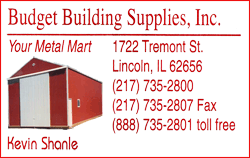 It's no wonder then that one of the most important decisions a
business owner can make is often left until it is too late to make a
rational and informed decision. This is a decision to sell a
business or close it while taking the maximum profit necessary to
maintain an accustomed lifestyle. It's no wonder then that one of the most important decisions a
business owner can make is often left until it is too late to make a
rational and informed decision. This is a decision to sell a
business or close it while taking the maximum profit necessary to
maintain an accustomed lifestyle.
Bill Hoagland addressed this topic in the September edition of
the Square Talk series he has instituted for Main Street Lincoln.
Hoagland is executive director of Main Street and co-founder of the
Jacy Group, a business consultancy with headquarters in Denver.
Square Talk is presented in the Main Street Lincoln office from
11:30 a.m. to 1 p.m. on the last Wednesday of each month.
The decision to sell a business is fraught with all sorts of
pitfalls and requires an extended period of time to make informed
choices and smooth the process. Hoagland recommends a minimum of
five years, and as many as seven, to make the decision to exit a
business. The planning is complex and should incorporate as many
experts as possible.

"The decision to exit a business is a very emotional process. The
owner should call upon certified financial planners, accountants and
legal advisers to help with the decision-making process," Hoagland
said.
These professionals can help analyze the current state of the
business and recommend changes that will enhance the value of the
company, as well as help with the decision to sell or liquidate.
Hoagland's experience helping companies focuses on those with a
value between $500,000 and $20 million.
One of the most important initial steps is to identify the "gap."
This is the amount of money a business owner needs after the sale to
maintain a desired lifestyle versus what the business is actually
worth. If the value of the business measured against the owner's
current personal wealth is determined to be less than what the owner
needs, then the "gap" has been identified.
The next step is to use the five- to seven-year lead time to
enhance the value enough to grow revenue. This is where consultants
may come into play to recommend value drivers that will make the
business worth more and help identify potential purchasers.
Value drivers are just that -- tactics that are necessary but may
have been neglected by the business owner. They include such things
as identifying business fundamentals and doing strategic planning.
Diversifying supplier relationships and collecting customer feedback
are other areas addressed by value drivers.
[to top of second column] |

Finally, it may be necessary to change the way financial
information is collected to more accurately reflect the value of the
company. Also determine benchmarks to ensure that the company is
accelerating its financials to meet the deadline for the transfer of
ownership.
While these measures may seem fundamental to running a business,
the day-to-day stress of business management may have caused them to
be neglected.
It is also a good idea to get an outsider's feedback on the
company, a fresh view of how it is being run. These are the areas
that a potential buyer will go over with a fine-toothed comb to
determine if the sale price is fair.
Finally, it will be necessary to determine the exit route from a
company, namely finding who would be available to purchase the
company. Hoagland referred to a Business Enterprise Institute list
that reduces the potential buyers to eight categories. Some of these
are selling to family members, which is the most common route;
selling to current employees; or third parties. In some cases,
business owners will find that simply closing the doors and
liquidating the company is the best course.
Hoagland also identified a list of reasons why businesses don't
sell. It is hoped that the application of the value drivers would
reduce or eliminate these.
Of course, because of the dynamic changes that happen in our
economy on a continuous basis, one important reason a business does
not sell is that the service or products are outdated. The need for
innovation is ongoing.

"Armed with the proper tools, advisers and time, you optimize
your chance for leaving your business in style," Hoagland said.
The next Square Talk seminar will be on Oct. 30 at 11:30 a.m. in
the Main Street office. The topic is "Effective Planning -- 2014 is
closer than you think". It will address turning a business owner's
vision into a strategy and then executing that strategy.
[By CURT FOX] |